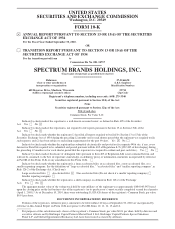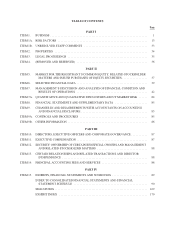Rayovac 2010 Annual Report Download - page 18
Download and view the complete annual report
Please find page 18 of the 2010 Rayovac annual report below. You can navigate through the pages in the report by either clicking on the pages listed below, or by using the keyword search tool below to find specific information within the annual report.associated products. Accordingly, we own the rights to use the REMINGTON trademark for electric shavers,
shaver accessories, grooming products and personal care products, while Remington Arms owns the rights to use
the trademark for firearms, sporting goods and products for industrial use, including industrial hand tools. In
addition, the terms of a 1986 agreement between Remington Products and Remington Arms provides for the
shared rights to use the REMINGTON trademark on products which are not considered “principal products of
interest” for either company. We retain the REMINGTON trademark for nearly all products which we believe
can benefit from the use of the brand name in our distribution channels.
We license the Black & Decker brand in North America, Latin America (excluding Brazil) and the
Caribbean for four core categories of household appliances: beverage products, food preparation products,
garment care products and cooking products. Russell Hobbs has licensed the Black & Decker brand since 1998
for use in marketing various household small appliances. In December 2007, Russell Hobbs and The Black &
Decker Corporation (“BDC”) extended the trademark license agreement for a third time through December 2012,
with an automatic extension through December 2014 if certain milestones are met regarding sales volume and
product return. Under the agreement as extended, Russell Hobbs agreed to pay BDC royalties based on a
percentage of sales, with minimum annual royalty payments as follows:
• Calendar year 2010: $14.5 million
• Calendar year 2011: $15.0 million
• Calendar year 2012: $15.0 million
The agreement also requires us to comply with maximum annual return rates for products.
If BDC does not agree to renew the license agreement, we have 18 months to transition out of the brand
name. No minimum royalty payments will be due during such transition period. BDC has agreed not to compete
in the four core product categories for a period of five years after the termination of the license agreement. Upon
request, BDC may elect to extend the license to use the Black & Decker brand to certain additional product
categories. BDC has approved several extensions of the license to additional categories and geographies.
Competition
In our retail markets, we compete for limited shelf space and consumer acceptance. Factors influencing
product sales include brand name recognition, perceived quality, price, performance, product packaging, design
innovation, and consumer confidence and preferences as well as creative marketing, promotion and distribution
strategies.
The battery product category is highly competitive. Most consumer batteries manufactured throughout the
world are sold by one of four global companies: Spectrum Brands (manufacturer/seller of Rayovac and VARTA
brands); Energizer Holdings, Inc. (“Energizer”) (manufacturer/seller of the Energizer brand); The Procter &
Gamble Company (“Procter & Gamble”) (manufacturer/seller of the Duracell brand); and Matsushita
(manufacturer/seller of the Panasonic brand). We also face competition from the private label brands of major
retailers, particularly in Europe. The offering of private-label batteries by retailers may create pricing pressure in
the consumer battery market. Typically, private-label brands are not supported by advertising or promotion, and
retailers sell these private label offerings at prices below competing name-brands. The main barriers to entry for
new competitors are investment in technology research, cost of building manufacturing capacity and the expense
of building retail distribution channels and consumer brands.
In the U.S. alkaline battery category, the Rayovac brand is positioned as a value brand, which is typically
defined as a product that offers comparable performance at a lower price. In Europe, the VARTA brand is
competitively priced with other premium brands. In Latin America, where zinc carbon batteries outsell alkaline
batteries, the Rayovac brand is competitively priced.
8
























